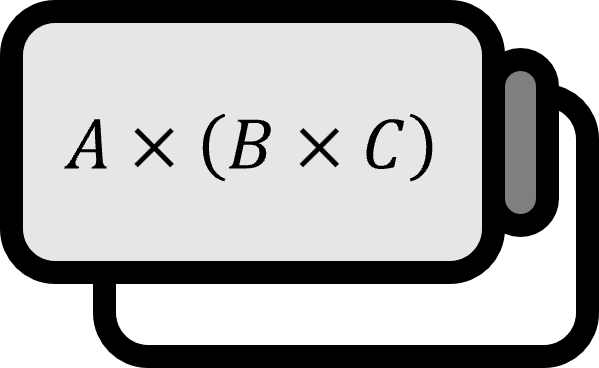デカルト座標系におけるベクトル、内積、外積の微分
公式
$\mathbf{A} = A_{x}\hat{\mathbf{x}} + A_{y}\hat{\mathbf{y}} + A_{z}\hat{\mathbf{z}}, \mathbf{B} = B_{x}\hat{\mathbf{x}} + B_{y}\hat{\mathbf{y}} + B_{z}\hat{\mathbf{z}}$を3次元直交座標系でのベクトルとしよう。$n$を任意のスカラーとする。すると、次の式が成立する。
(a) $\dfrac{ d \left( n \mathbf{A} \right) }{dt} = \dfrac{ dn }{dt} \mathbf{A} + n\dfrac{ d\mathbf{A}}{dt}$
(b) $\dfrac{ d ( \mathbf{A} \cdot \mathbf{B} )}{dt} = \dfrac{ \mathbf{A} }{dt} \cdot \mathbf{B} + \mathbf{A} \cdot \dfrac{ d\mathbf{B}}{dt}$
(c) $\dfrac{ d ( \mathbf{A} \times \mathbf{B}) }{dt} = \dfrac{ d \mathbf{A} } {dt} \times \mathbf{B} + \mathbf{A} \times \dfrac{ d \mathbf{B} } {dt}$
説明
高校生の頃から知っている積の微分法を思い出すと、結果を自然に受け入れることができるだろう。まず$\mathbf{A}$の導関数を計算してみよう。
$$ \begin{align*} \dfrac{ d \mathbf{A} } { dt } =& \dfrac{d}{dt} \left(A_{x}\hat{\mathbf{x}} + A_{y}\hat{\mathbf{y}} + A_{z}\hat{\mathbf{z}} \right) \\ =& \dfrac{ d A_{x} }{dt} \hat{\mathbf{x}} + A_{x} \dfrac{d \hat{\mathbf{x}}}{dt} + \dfrac{ d A_{y} }{dt} \hat{\mathbf{y}} + A_{y} \dfrac{d \hat{\mathbf{y}}}{dt} + \dfrac{ d A_{z} }{dt} \hat{\mathbf{z}} + A_{z} \dfrac{d \hat{\mathbf{z}}}{dt} \\ =& \dfrac{ d A_{x} }{dt} \hat{\mathbf{x}} + \dfrac{ d A_{y} }{dt} \hat{\mathbf{y}} + \dfrac{ d A_{z} }{dt} \hat{\mathbf{z}} \\ =& \left( \dfrac{ d A_{x} }{dt}, \dfrac{ d A_{y} }{dt}, \dfrac{ d A_{z} }{dt} \right) \end{align*} $$
各方向の単位ベクトルは時間によって変わらないため、微分した時に$\mathbf{0}$である。この結果からベクトル関数の導関数もやはりベクトル関数であることがわかる。また、次の式も成立することがわかる。
$$ \left( \dfrac{ d \mathbf{A} } {dt} \right)_{x}=\dfrac{ d A_{x}}{ dt} $$
しかし、この式は一般的に成立するわけではなく、直交座標系でのみ成立するので注意が必要である。単位ベクトルが時間によって変わる場合には成立しない。例えば極座標系での速度と加速度は次のようである。
$$ \begin{align*} \mathbf{v}=&\dot{r} \hat{\mathbf{r}} + r \dot{\theta} \hat{\boldsymbol{\theta}} \\ \mathbf{a}=& (\ddot r -r\dot{\theta} ^2)\hat{\mathbf{r}} + (2\dot{r} \dot{\theta} + r\ddot{\theta})\hat{\boldsymbol{\theta}} \end{align*} $$
すると、以下の等式が成立しないことがわかる。
$$ \left( \dfrac{d \mathbf{v}}{dt} \right)_{\theta} = a_{\theta} = 2\dot{r} \dot{\theta} + r\ddot{\theta} \ne \dot{r}\dot{\theta} + r\ddot{\theta} = \dfrac{d v_{\theta}}{dt} $$
証明
(a)
$$ \begin{align*} \dfrac{ d (n\mathbf{A}) }{ dt} =& \dfrac{ d}{dt} (nA_{x}\hat{\mathbf{x}} + nA_{y}\hat{\mathbf{y}} + nA_{z} \hat{\mathbf{z}}) \\ =& \left( \dfrac{dn}{dt}A_{x} + n\dfrac{dA_{x}}{dt} \right) \hat{\mathbf{x}} +\left( \dfrac{dn}{dt}A_{y} + n \dfrac{dA_{y}}{dt} \right) \hat{\mathbf{y}} + \left( \dfrac{ dn }{ dt } A_{z} + n \dfrac{ d A_{z} }{dt } \right) \hat{\mathbf{z}} \\ =& \dfrac{dn}{dt} \left( A_{x} \hat{\mathbf{x}} + A_{y} \hat{\mathbf{y}} + A_{z} \hat{\mathbf{z}}\right) + n \left( \dfrac{ dA_{x}}{dt}\hat{\mathbf{x}} + \dfrac{dA_{y}}{dt}\hat{\mathbf{y}} + \dfrac{dA_{z}}{dt} \hat{\mathbf{z}} \right) \\ =& \dfrac{ dn } {dt } \mathbf{A} + n\dfrac{ d \mathbf{A} }{ dt } \end{align*} $$
■
(b)
$$ \begin{align*} \dfrac{ d (\mathbf{A} \cdot \mathbf{B})} {dt} =& \dfrac{d}{dt}\left( A_{x}B_{x} + A_{y}B_{y} + A_{z}B_{z} \right) \\ =& \left( {\color{blue}\dfrac{ d A_{x}}{dt}B_{x}} + A_{x}\dfrac{ d B_{x}}{dt} \right) + \left( {\color{blue}\dfrac{ dA_{y}}{dt}B_{y} } + A_{y}\dfrac{d B_{y}}{dt} \right) + \left( {\color{blue} \dfrac{ d A_{z}}{dt}B_{z} }+ A_{z}\dfrac{dB_{z}}{dt}\right) \\ =& \left( {\color{blue}\dfrac{ d A_{x}}{dt}B_{x} + \dfrac{ dA_{y}}{dt}B_{y} + \dfrac{ d A_{z}}{dt}B_{z} } \right) + \left( A_{x}\dfrac{ d B_{x}}{dt} + A_{y}\dfrac{d B_{y}}{dt} + A_{z}\dfrac{dB_{z}}{dt} \right) \\ =& \left[ \left( \dfrac{ d \mathbf{A}}{dt}\right)_{x}B_{x} + \left(\dfrac{ d\mathbf{A}}{dt}\right)_{y}B_{y} + \left( \dfrac{ d \mathbf{A}}{dt}\right)_{z}B_{z} \right] + \left[ A_{x} \left( \dfrac{ d \mathbf{B}}{dt} \right)_{x} + A_{y} \left( \dfrac{d \mathbf{B}}{dt}\right)_{y} + A_{z} \left( \dfrac{d \mathbf{B} }{dt} \right)_{z}\right] \\ =&\dfrac{d\mathbf{A}}{dt}\cdot \mathbf{B} + \mathbf{A}\cdot \dfrac{d\mathbf{B}}{dt} \end{align*} $$
■
(c)
$$ \begin{align*} \dfrac{d( \mathbf{A} \times \mathbf{B}) }{ dt } =& \dfrac{ d}{dt} \left[ \hat{\mathbf{x}} (A_{y}B_{z}-A_{z}B_{y})+ \hat{\mathbf{y}} (A_{z}B_{x}-A_{x}B_{z}) + \hat{\mathbf{z}} (A_{x}B_{y}-A_{y}B_{x}) \right] \\ =& \hat{\mathbf{x}} \left( {\color{blue} \dfrac{ dA_{y}}{dt}B_{z} } +A_{y}\dfrac{d B_{z}}{dt} {\color{blue} -\dfrac{d A_{z}}{dt}B_{y} } –A_{z}\dfrac{B_{y}}{dt} \right) + \hat{\mathbf{y}} \left( {\color{blue} \dfrac{ dA_{z}}{dt}B_{x} } +A_{z}\dfrac{d B_{x}}{dt} {\color{blue} -\dfrac{d A_{x}}{dt}B_{z} } –A_{x}\dfrac{B_{z}}{dt} \right) \\ &\quad + \hat{\mathbf{z}} \left( {\color{blue} \dfrac{ dA_{x}}{dt}B_{y} } +A_{x}\dfrac{d B_{y}}{dt} {\color{blue} -\dfrac{d A_{y}}{dt}B_{x} } –A_{y}\dfrac{B_{x}}{dt} \right) \\ =& {\color{blue} \left[ {\color{black} \hat{\mathbf{x}} \left( \dfrac{ dA_{y}}{dt}B_{z}-\dfrac{d A_{z}}{dt}B_{y}\right) + \hat{\mathbf{y}} \left( \dfrac{ dA_{z}}{dt}B_{x}-\dfrac{d A_{x}}{dt}B_{z} \right) + \hat{\mathbf{z}} \left( \dfrac{ dA_{x}}{dt}B_{y}-\dfrac{d A_{y}}{dt}B_{x} \right)} \right] } \\ &\quad + \left[ \hat{\mathbf{x}} \left( A_{y}\dfrac{d B_{z}}{dt}-A_{z}\dfrac{d B_{y}}{dt} \right) + \hat{\mathbf{y}} \left( A_{z}\dfrac{d B_{x}}{dt}-A_{x}\dfrac{d B_{z}}{dt} \right) + \hat{\mathbf{z}} \left( A_{x}\dfrac{d B_{y}}{dt}-A_{y}\dfrac{d B_{x}}{dt} \right) \right] \\ =& \dfrac{d\mathbf{A}}{dt} \times \mathbf{B} + \mathbf{A} \times \dfrac{d \mathbf{B}}{dt} \end{align*} $$
■
